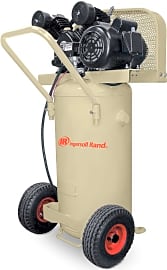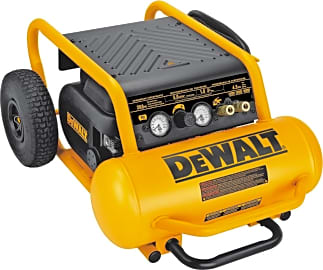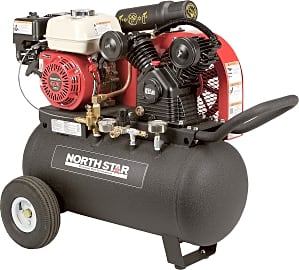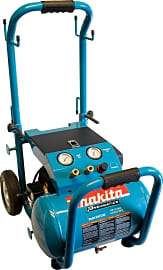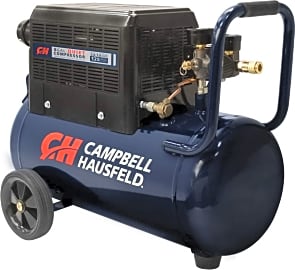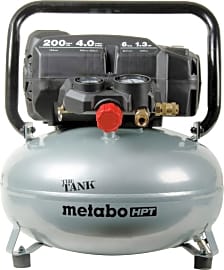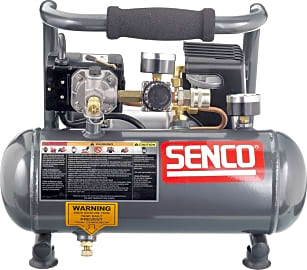The 10 Best Air Compressors

This wiki has been updated 38 times since it was first published in March of 2015. A good compressors is essential for many workshops, as it can supply clean, high-pressure air to power various pneumatic tools, such as nail guns and paint sprayers. We've included models on our list ranging from smaller units that are great for home users, all the way up to behemoths built for industrial applications. Observe all appropriate safety protocols when working with pressurized tanks. When users buy our independently chosen editorial choices, we may earn commissions to help fund the Wiki.
Editor's Notes
December 03, 2020:
We removed the DeWalt DWFP55126 in favor of the Metabo The Tank. Both are pancake-style compressors, however, the Matbo The Tank has a slight edge in functionality as it's capable of supporting more tools with a higher CMF. Similarly, the California Air Tools 8010A was swapped out for the Craftsman 1.8 HP. Both have a relatively similar size, however, the Craftsman 1.8 HP performs slightly better and has a lower price.
The Campbell Hausfeld DC080500 was updated to the company's latest model, the Campbell Hausfeld AC080510, which features a shroud-covered design for safety.
It's always important to make sure the appropriate safety measures are taken when working with compressed air. Make sure all components, including hoses and fittings, are rated for the maximum pressure of the compressor.
December 04, 2019:
Removed the Porter-Cable C2002-WK and the Bostitch BTFP02012 in favor of the Campbell Hausfeld XC302100 and the Ingersoll-Rand P15IU-A9. Both the Porter-Cable and the Bostitch use friction drilling to open holes for the tank's check valves. This also creates a surface to tap the threads needed for the valves. While this process cuts costs, it is also much more prone to leaking than the welded inserts found on the Campbell Hausfeld and the Ingersoll-Rand. The reason is that since the mating surface on the pressure tank is thinly extruded, there is no place to use a proper bonded seal or an o-ring(both use effective elastomer gasket materials). As a result, these manufacturers have to use a wedging national pipe thread fitting which builds in a natural path for leakage.
Working with pressurized vessels is dangerous. Always ensure that you evacuate the tank pressure before removing or manipulating any fittings.
Special Honors
Ingersoll-Rand R-Series While quite expensive, this compressor uses a rotary-type positive displacement mechanism that produces a large-volume of air for powering the most demanding tools such as pneumatic jack hammers and multiple impact wrenches. ingersollrandproducts.com
Stored Energy For The Toughest Jobs
This inversely increases the volume of air pressure inside the chamber as oxygen continues to be forced in.
Regardless of whether you're a professional contractor, painter, automotive mechanic, or a do-it-yourself (DIY) homeowner bent on taking care of the tough domestic jobs, ordinary elbow grease isn't always enough to get the job done, particularly when you need speed, pressure, and power to make your pneumatic tools work properly. For that reason, you're going to need a good-quality air compressor to help you maximize your efforts and use those air tools successfully.
Using either an electric motor, diesel, or gas engine, an air compressor is a device that converts power into potential energy stored in pressurized air. By potential energy, we are referring to the energy stored within an object not currently in motion, but capable of becoming active. To clarify, imagine standing atop a large staircase. If gravity can pull you downward (e.g. falling), then you have gravitational potential energy even though you're not actually tumbling down the stairs at the moment. Should you actually fall, then you are releasing kinetic energy, which is defined as the energy of motion.
The air compressor stores potential energy in the form of pressurized air even though the air isn't currently in motion until it is released. Through several methods, the compressor forces air into a storage tank where it is kept under pressure until it is used to power a variety of tools. Upon the air's release from a compressor tank, what was once potential energy is now kinetic energy because the air is in motion. As air continues to be released from the compressor, the pressure inside the tank decreases. When the pressure reaches its lower limit, the compressor will turn on and re-pressurize the tank to be used again.
Air compressors fall into two methods of operation, positive and negative displacement. With a positive displacement compressor, air is trapped between two moving components where it is continually forced into a chamber of decreased volume. This inversely increases the volume of air pressure inside the chamber as oxygen continues to be forced in. Positive displacement compressors use oil as a lubricant at their motor's compression point with built-in systems designed to remove the oil from the air to prevent contamination upon its release. After all, no professional painter wants oil coming from an air compressor that is being used to spray paint a wall. Negative displacement compressors leverage the kinetic energy from rotating components to create pressure. These devices operate without producing the true physical displacement that positive compressors require to operate. Negative displacement compressors are characterized by greater pressure fluctuations due to the speed of their rotating elements, like an impeller, making them well-suited for use in low-pressure applications.
The most common type of positive displacement compressor is the piston (also known as a reciprocating) compressor. This device features one-way valves to guide air into cylindrical chambers where it is pressurized. A car's engine, for example, operates using a similar principle but in reverse, as the vehicle's internal combustion process pushes the piston rather than the piston pushing the gas.
Reciprocating compressors are available as either single-stage or two-stage devices. A single-stage compressor works by drawing air in and pressurizing it with a single stroke of its piston. With two-stage compressors, air is pulled in and compressed to an intermediate level of pressure during the first stage and it is then piped by an intercooler during the second stage prior to its release. Another type of positive displacement compressor is the rotary screw compressor, which uses helical rotating screws to guide air into a chamber, whose volume is decreased as the screws rotate.
There are also dynamic-style rotary centrifugal compressors that depend on the transfer of energy from a rotating impeller to the air. These devices typically rotate at higher speeds than other compressors, which also means they have a higher capacity due to the continuous flow through their impellers.
Professional Considerations Are Key
Before choosing a compressor, one must determine the environment in which they plan to use the device and the amount of power required to run their operations. This depends greatly on the nature of one's profession. For example, automotive work is typically done within a garage, so having access to available power outlets will be key to determining which device works best. By contrast, if you plan to be doing a lot of construction work outdoors requiring the use of nail guns or other pneumatic tools without close access to power outlets, consider a portable air compressor. These also come in handy when pumping up sports equipment (e.g. basketballs).
Before choosing a compressor, one must determine the environment in which they plan to use the device and the amount of power required to run their operations.
The profession also dictates the types of pneumatic tools that are applicable to your job, which ultimately determines the best type of compressor. One should take their time to ensure the device they go with offers all of the features and power necessary to complete their work. Stationary compressors often have a greater capacity for pressurized air storage while providing increased cubic feet per minute (CFM) and pounds per square inch (PSI) output.
Finally, consider the power source for the compressor you choose. A gas-powered compressor provides power to your tools in virtually any indoor or outdoor setting, which is beneficial for contractors and DIY jobs at home. However, if you're worried about carrying heavy loads to job sites, an electrically-powered compressor may weigh substantially less, saving you from a great deal of heavy lifting.
A Brief History Of Air Compressors
The first functional air compressor was actually the human lung. Our earliest ancestors often used their own natural air pressure to help stoke fires. However, this practice was hardly practical as human civilization continued to develop. By 1500 BCE, the bellows was invented, which was a hand-held (and later foot-controlled) flexible bag that produced a concentrated blast of air, making it ideal for achieving high-temperature fires.
Today, several types of compressors are available for many different industrial and domestic applications.
Fast forward to the year 1762 and we learn that professional engineer John Smeaton designed a water wheel-driven blowing cylinder that eventually replaced the bellows. By 1776, Smeaton’s device was replaced by a new blasting machine invented by John Wilkinson, which became the standard model upon which later mechanical air compressors would be based.
By the beginning of the nineteenth century, people began using air compressors to transmit energy. Compressed air was introduced to the drilling process by 1861, which was a very welcome convenience for the construction of the Mont Cenis Tunnel in the Swiss Alps, speeding up drilling efficiency to 14.89 feet per day.
Continued innovations gradually began incorporating electricity and pneumatic energy into the devices. Air compressors led to the invention of pneumatic tubes in which the air would flow, creating the driving power behind the device and paving the way for the use of pneumatic tools. The first practical use of a pneumatic tool was the rock drill, invented by Simon Ingersoll of Ingersoll Rand in 1871. Ingersoll's company also supplied the air compressors used to construct Mount Rushmore in 1927. Today, several types of compressors are available for many different industrial and domestic applications.



